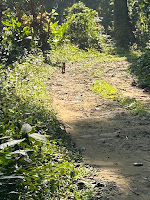Andamans Day 6 - The Black Baza of Kalatang and the history of names
Feb 15th 2024
We were blessed with another Andaman sunrise as we set off to revisit Kalatang. Wherever you go, you are never far from a sunrise or sunset - the daily joy of an Island life.
As we waited for the ferry, this signboard caught my eye.
 |
| The name-changing of some of the Islands. |
In Jan 2023, 21 islands were renamed after Param Vir Chakras. A few years earlier there was renaming of the more popular islands - Ross Island has become Netaji Subhash Chandra Bose Island, Havelock and Neil Islands have become Swaraj and Shaheed Islands. From what I can make out, the Islanders are confused and continue to use the old names.
As I sat in the car, I mulled over the name changes, who were the original inhabitants? Should we not acknowledge them in some way. Even the place names on the islands reflect the settlers's history/arrival.
Can we acknowledge the original human and non-human inhabitants?
I wished one island was named for the White-Bellied Sea Eagle - such an iconic species in the islands. One for the Saltwater crocodile and another for those Sea Mahua trees, and maybe Yadita island as well- the Andamanese word for sea turtles. Names - they enter our imagination, keep us connected to the origins of the place, make us curious about the history and most importantly acknowledge and include the "other".
I found this about "Baratang" -
Baratang Island separated from South Andaman Island by the Amitla Boicha passage and Middle Andaman by Homfrays Strait was exclusively the territory of the Aka-Pucikwar. In the Andaman Islands, Baratang is the only island to retain its name to the present day since the earliest times. Gerini (1909), in his study of Ptolemaic geography refers to Baratang as one of the islands named as such since the travels of both Ptolemy and Ibn Batuta. The island, earlier known to be inhabited by the Aka-Bojigyab- Da (Pucikwar) or speakers of the original language, also has patches of land exclusively vegetated by the Talipot Palm, (C. Umbraculifera Linn) called ‘Barata’ by the Andamanese. The palm assumes immense significance in Andamanese mythological beliefs as the plant is related to the evolution of the earth and human life (Radcliffe-Brown 1922: 171).
(Jarawa Tribal Reserve Dossier, A dossier prepared by Kalpavriksh. Edited by Pankaj Sekhsaria and Vishvajit Pandya)
Talipot Palm!! I did not notice a single one while on the islands, and I see none on iNaturalists either, so where are these palms now? Extinct?
 |
| Pg 23 from Yuvan's Intertidal - lists some vocabulary of the Nicobarese. "Ank" - the call of the WBSE! |
We caught the ferry and reached the Kalatang (Wonder what that name means!) forest road.
Andaman Green Imperial Pigeons greeted us. Long Tailed Parakeets sat on the tallest branches. Black Naped Orioles called to each other and flew from branch to branch. Starlings sat preening in groups as well.
 |
| A pair of Greater Racket Tailed Drongos swung on a liana. |
 |
| That distinctive crest oh so close calligraphy strokes Black and white |
 |
| The Black Baza (Aviceda leuphotes) is an oh so small and elegant raptor. I wonder why its called a bird of prey - seems to feed on insects, as do many non-bird of prey. |


Then, we headed back, missing the 930 return ferry to Chatham saw mill, and so our driver took us by the land route instead of waiting for the next ferry, and so we saw some of the wetlands on the way, and spied Cotton Pygmy geese, Egrets, circling WBSE and more.
It was back to Rainbird hotel for lunch and a chota snooze. After lunch, the others went off to Ograbaj again.










Comments
Post a Comment